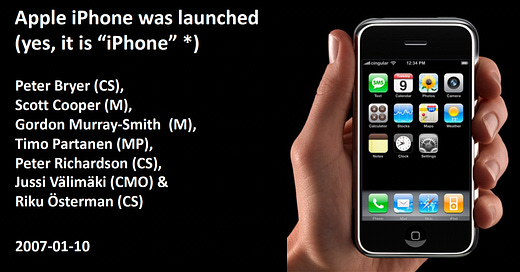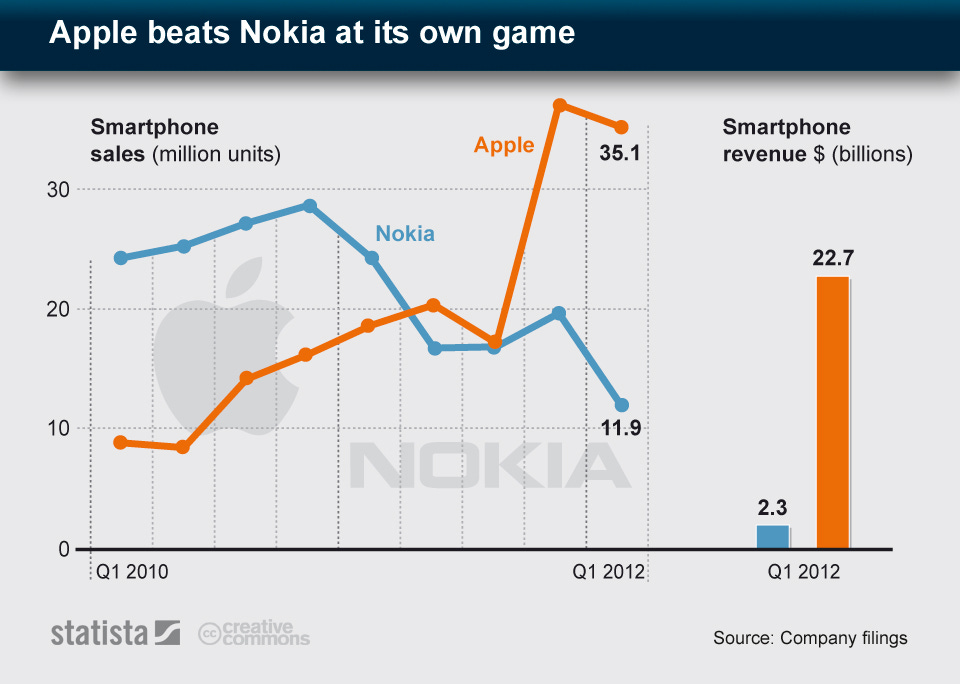Venturing Insights #30 - Nokia saw the iPhone coming. So why did it still fail?
Key insights from Nokia’s internal reaction to the iPhone launch.
Previously on Open Road Ventures: In the last episode of Venturing Insights, we had a deep dive on incentives for corporate venturing. If you missed it, you can catch up here!
In 2007, an internal Nokia presentation analyzed the iPhone launch. They saw the threat. They called it a game-changer. They even outlined exactly what needed to be done to compete.
And yet… we all know how that story ended.
So what went wrong? Here are 6 brutal lessons on disruption, strategy, and corporate inertia—straight from Nokia’s own internal playbook:
1. Nokia Saw the Threat Clearly—But Moved Too Slowly
• Nokia immediately recognized that the iPhone’s touchscreen UI and seamless internet integration could redefine the smartphone experience.
• The company acknowledged that its own user interface strength was eroding and that urgent action was needed.
• Despite recognizing the need to develop a competing touch UI, internal fragmentation slowed down decision-making.
🔹 Takeaway: Seeing disruption coming isn’t enough—speed of execution determines survival.
2. Internal Silos and Strategic Confusion Were Major Roadblocks
• Nokia suggested appointing a Chief UI Architect to break down silos and drive a unified UX strategy—an implicit acknowledgment that internal divisions were impeding progress.
• The company debated whether to focus on S60 (Symbian) or Maemo (Linux-based platform), with no clear resolution.
• There were competing priorities between high-end feature phones (N-Series) and experimental platforms like Maemo.
🔹 Takeaway: Bureaucracy and internal politics can be more dangerous than external competition.
3. Nokia Dismissed the iPhone’s Lack of Features—But Missed the Bigger Picture
• Nokia noted that the iPhone lacked 3G, Java, a removable battery, and a high-resolution camera, seeing this as a competitive weakness.
• However, it underestimated Apple’s ability to compensate with a game-changing user experience and app ecosystem.
• The company wrongly assumed that the iPhone would be limited to high-end consumers, failing to anticipate future, lower-cost models.
🔹 Takeaway: Market disruption isn’t just about specs—it’s about redefining the user experience.
4. Nokia Overestimated the Strength of Its Business Model
• The company believed that the iPhone’s high price ($499–$599 with a 2-year contract) would limit its market penetration.
• Nokia planned to counter with price cuts on its N-Series devices, rather than innovating around experience.
• It underestimated carrier dynamics, assuming operators would push back against Apple’s control—yet Apple’s exclusivity with Cingular (AT&T) reshaped industry power dynamics.
🔹 Takeaway: A strong market position today doesn’t guarantee survival tomorrow—you must adapt, not just defend.
5. Defensive Strategy: Copy & Undermine Rather Than Innovate
• Nokia considered a “steal Apple’s coolness” approach by making N-Series devices look more like iPhones.
• There was a suggestion to saturate the mid-range market with competitive products to “kill” the iPhone’s premium appeal.
• The company also discussed possible legal action against Apple for IP infringement.
🔹 Takeaway: Competing through imitation and legal battles is a weak response to genuine disruption.
6. What Nokia Could Have Done Differently
The presentation suggests alternative paths that could have been more successful:
• Double down on UI innovation: Invest aggressively in a true next-gen user experience rather than iterating on Symbian.
• Accelerate Maemo (Linux-based platform): The company identified this as a strength but failed to commit fully. This could have been Nokia’s Android moment.
• Rethink operator relationships: Instead of reacting defensively, Nokia could have proactively worked with carriers on new business models.
• Embrace the app economy sooner: Apple’s walled garden approach was dismissed at the time, but it became a defining strength.
🔹 Takeaway: When faced with disruption, companies must pivot boldly, not cling to existing structures.
Final Thought: The Tragedy of a Missed Pivot
Nokia wasn’t blind to disruption, but its internal conflicts, slow decision-making, and defensive mindset ensured it couldn’t pivot fast enough. The iPhone was more than a new phone—it was a platform shift that Nokia failed to counter effectively.
For today’s corporate innovators, the lesson is clear:
Identifying disruption is the easy part—acting decisively is the real challenge.
As usual, a soundtrack for you:










